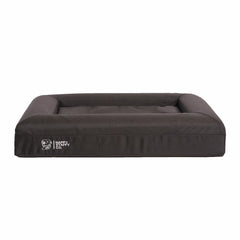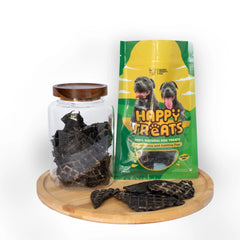If you’ve ever watched your dog spin in circles, dig furiously at their bed, and then plop down as if nothing happened, you might have wondered: Why do dogs scratch their beds? This quirky habit isn’t just random behavior—it has deep roots in their instincts and emotions, such as creating a comfortable nest, marking their territory, or self-soothing when anxious.
The reason dogs scratch their beds is to create a safe, comfortable space that feels familiar and secure. Understanding why your dog does this can help you provide them with comfort and ensure their overall well-being.
Key Takeaways
-
Dogs scratch their beds to create comfort – This nesting behaviour helps them adjust their sleeping spot for softness, temperature, and security.
-
Scratching often marks territory – Dogs have scent glands in their paws, so bed scratching helps them claim their space in multi-pet households.
-
Anxiety and stress can trigger scratching – Changes in routine, new environments, or unfamiliar guests may prompt dogs to scratch for reassurance.
-
Excess energy fuels bed-scratching – Without enough physical or mental stimulation, dogs may redirect their energy into digging at their beds.
-
Scratching can signal discomfort or health issues – Excessive digging may point to allergies, joint pain, or the need for a better-quality bed.
Behavioral Reasons Why Dogs Scratch Their Beds:

While bed scratching is often instinctual, it can also reflect your dog’s emotional state, physical needs, or environmental influences.
Comfort and Temperature Regulation
Dogs scratch their beds to create the perfect sleeping environment. This behavior mimics their ancestors’ actions of pawing at dirt or grass to make a soft and comfortable resting place. Scratching can help fluff up bedding or align it to better support their body. It also allows dogs to locate the coolest or warmest spot in their sleeping area, depending on their comfort needs. If your dog seems to scratch excessively, it may indicate that their bedding isn’t meeting their comfort or temperature regulation needs, such as being too thin, too warm, or lacking proper padding.
Anxiety or Stress
Bed scratching can act as a self-soothing mechanism for anxious or stressed dogs. Changes in their environment, such as moving to a new home, introducing a new pet, or even the presence of unfamiliar visitors, can heighten their need to feel secure. Scratching may help them release nervous energy or mark the area with their scent, creating a sense of familiarity and comfort. If anxiety is a recurring issue, addressing the root cause through calming techniques, additional reassurance, or consulting a veterinarian may help reduce this behavior.
Excess Energy
Dogs with unspent energy often resort to behaviors like scratching or digging. If your dog hasn’t had enough physical activity or mental stimulation during the day, they may channel their pent-up energy into their bedding. Scratching becomes a way for them to stay engaged or tire themselves out. Providing more exercise, toys, or interactive play sessions can help redirect their energy into healthier outlets.
Environmental Factors
External factors, such as loud noises, unfamiliar surroundings, or sudden changes in routine, can trigger bed scratching as a coping mechanism. For example, thunderstorms, fireworks, or a new sleeping location can make dogs feel uneasy, prompting them to scratch in an effort to feel secure. Consistency in their environment and reassurance during stressful situations can minimise this behavior.
Territorial Behavior
Scratching can also be a way for your dog to claim their space. The act of digging releases their scent from the glands in their paws, marking their bed as their own. This territorial behavior is more common in multi-pet households where dogs may feel the need to reinforce ownership of their sleeping area.
Attention-Seeking Behavior
In some cases, bed scratching may simply be your dog’s way of gaining attention. If they notice that scratching prompts a reaction from you, they might continue doing it as a learned behavior to interact with you. Offering positive reinforcement when they are calm and settled can help discourage this attention-seeking pattern.
They’re Trying to Get Cozy
Often, bed scratching is simply your dog’s way of creating a comfortable sleeping environment. Pawing and digging at their bed help them settle into a position that feels just right. It’s their way of achieving a cozy space where they can relax.
Health-Related Concerns
Occasionally, excessive scratching can point to an underlying health issue, such as allergies, skin irritations, or joint pain. If your dog appears uncomfortable, scratches frequently, or has other symptoms like licking, redness, or limping, it’s essential to consult a veterinarian to rule out medical concerns.
By observing the context and frequency of your dog’s bed scratching, you can gain valuable insights into their mental and physical state. Addressing their needs—whether it’s improving their bedding, increasing exercise, or providing a more stable environment—can help reduce this behavior while improving their overall comfort and happiness.
Instincts Behind Bed Scratching
For thousands of years, dogs have relied on scratching as an instinctive behavior to prepare their resting spaces. These deeply rooted habits, passed down from their wild ancestors,
|
Instinct |
Reason |
|
Preparing a Resting Spot |
Dogs scratch to remove debris such as dirt, grass, or leaves, ensuring their sleeping area is comfortable and safe, just as their ancestors did in the wild. |
|
Territorial Marking |
Scratching activates scent glands in their paws, releasing pheromones that mark the area as their territory, providing a sense of security and ownership. |
|
Creating a Cozy Nest |
Scratching mimics the behavior of building a nest, allowing dogs to arrange their bedding into a snug and protective spot where they feel safe and relaxed. |
Even if your dog’s bed seems perfect to you, their instincts compel them to adjust and personalise it, making it a ritual deeply tied to their sense of safety and comfort.
The Impact of Breed on Bed-Scratching Behavior
Certain dog breeds are more inclined to scratch or dig at their beds, and this behavior often stems from their genetic traits and historical roles.
-
Working Breeds: Breeds like Siberian Huskies, Malamutes, and other working dogs were bred for outdoor tasks in harsh environments. Their tendency to dig or scratch often reflects the instinct to create a shelter or regulate their sleeping space’s temperature.
-
Herding Breeds: Dogs like Border Collies or Australian Shepherds may engage in bed scratching as part of their energetic and task-driven nature, which requires mental and physical stimulation.
-
Terrier Breeds: Terriers are famous for their digging instincts, originally bred to hunt small animals and burrow into dens. Scratching at their beds can mimic this natural behavior, making it a deeply ingrained habit for these energetic dogs.
Understanding your dog’s breed-specific tendencies can help you better manage and address bed-scratching behavior. By providing appropriate outlets, such as exercise or mental stimulation, you can help satisfy their instincts while keeping this behavior under control.
Medical Concerns to Watch For
While bed scratching is usually harmless, there are times it might signal an underlying issue.
Skin Irritations or Allergies: If your dog is scratching themselves and their bed excessively, it could indicate skin issues or allergies. Pay attention to redness, itching, or hair loss.
Joint Pain or Discomfort: Older dogs or those with arthritis may scratch their beds to find a position that relieves pain. They’re instinctively trying to make themselves more comfortable.
Obsessive-Compulsive Behaviors: Excessive scratching or digging could be a sign of compulsive behavior, which may require help from a veterinarian or behaviorist.
If you’re concerned about your dog’s scratching habits, don’t hesitate to consult a professional. Early intervention can make a big difference.
When Their Bed Isn’t Comfortable Enough

Sometimes, the problem lies with the bed itself. If your dog’s bed is too small, too hard, or lacks cushioning, they may scratch in an attempt to make it more suitable.
-
Upgrade Their Bedding: Opt for a high-quality, durable, and appropriately sized dog bed. Consider options like orthopedic or memory foam beds for older dogs or those with joint pain.
Tips to Redirect Bed-Digging Behavior
If bed-digging becomes excessive or problematic, there are effective methods to help redirect this behavior:
Increase Exercise and Play: Ensure your dog gets enough physical activity to release pent-up energy. A tired dog is less likely to dig obsessively.
Provide Mental Stimulation: Toys or training sessions can keep your dog engaged and reduce anxiety-driven digging.
Reinforce Positive Behavior: Reward your dog when they settle into their bed calmly without excessive scratching.
Effective Methods to Reduce Compulsive Digging
For dogs with compulsive digging habits, try these strategies:
Create a Calming Environment: Use calming sprays, white noise, or soothing blankets to help your dog feel more secure.
Consult a Veterinarian: If digging is linked to anxiety or medical issues, a vet can help address the root cause.
Professional Training: A behaviorist can offer tailored advice to manage and reduce compulsive digging.
Common Questions
Can a Blanket Help My Dog Feel Secure in Bed?
Absolutely! A soft blanket can offer additional comfort and warmth, helping your dog feel safe and cozy.
Is It Possible to Reduce Compulsive Digging Yourself?
You can reduce compulsive digging by addressing its underlying causes. This includes increasing exercise, reducing anxiety, and providing a comfortable sleeping area.
Should I Be Concerned About Bed Digging?
Bed digging is usually normal behavior. However, if it becomes excessive or is accompanied by signs of distress, it’s worth consulting a veterinarian or behaviorist.
Does the Type of Dog Bed Affect Digging Behavior?
Yes, the right bed can make a big difference. Beds that are too hard, small, or lack support can lead to more digging as your dog tries to make it comfortable.
Understanding Your Dog’s Quirks
Scratching their bed may seem like a strange habit, but for dogs, it’s perfectly natural. From ancestral instincts to modern behavioral needs, this action helps them feel comfortable, secure, and at ease.
At Happy Staffy, we celebrate these quirks as part of what makes every dog special. Whether it’s a playful pup or a loyal companion pawing at their bed, this behavior is their way of creating a cozy, personal space. By observing your dog and providing the right support, you can ensure their bed-scratching routine remains a harmless and endearing part of their daily life. If you ever feel concerned, remember that professionals like veterinarians and behaviorists are there to help.
After all, every scratch and paw is just another way your dog is being their unique, lovable self.




